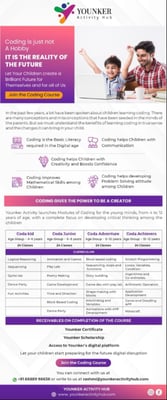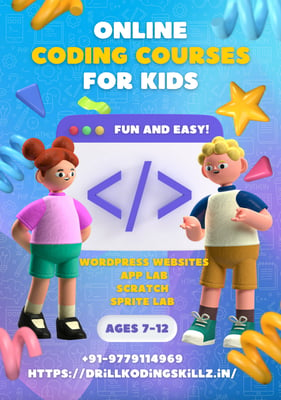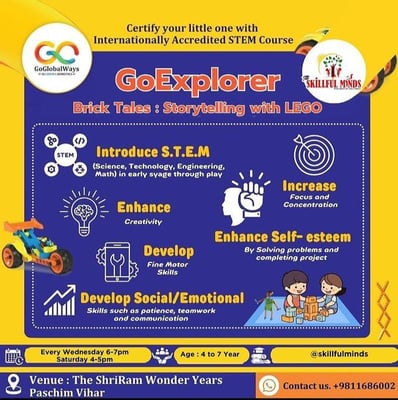Coding classes for Kids - 32 options found
Coding classes for children aged 2 to 15 provide cognitive d... Coding classes for children aged 2 to 15 provide cognitive development, creativity, math understanding, technology literacy, career readiness, and collaboration skills. Through logical thinking and project-based learning, children develop problem-solving abilities, innovation mindsets, and digital literacy essential for future careers in STEM fields. Starting with visual programming languages like Scratch, children progress to text-based languages like Python, gaining skills applicable across various industries. Collaboration on coding projects fosters communication and teamwork. Overall, coding classes equip children with essential skills for success in a technology-driven world and prepare them for diverse career opportunities in the digital economy. Read more
linstitutgenesis-python course
robotronix stem lab-steam & robotics program
skillful minds-brick tales-storytelling with lego
Advantages of Coding Classes for Children Ages 2 to 15
Coding classes for children aged 2 to 15 offer numerous benefits, from cognitive development to enhanced problem-solving skills and future career opportunities. In this comprehensive guide, we'll explore the advantages of coding classes for children in this age range, potential limitations, and address common questions regarding its impact on brain development, personality development, and career prospects.
Introduction
Coding, or computer programming, is the process of creating instructions for computers to execute tasks. Coding classes for children provide structured learning environments where they can develop coding skills through interactive activities, games, and projects.
Advantages
-
Cognitive Development:
- Logical Thinking: Coding teaches children to think logically and sequentially, breaking down complex problems into smaller, more manageable steps.
- Problem-Solving Skills: Through coding challenges and projects, children learn to identify problems, formulate solutions, and debug errors, fostering critical thinking and analytical abilities.
-
Creativity and Innovation:
- Project-Based Learning: Coding classes often involve hands-on projects where children can unleash their creativity and imagination, designing games, animations, and applications.
- Innovation Mindset: Learning to code encourages children to explore new ideas, experiment with different approaches, and develop innovative solutions to real-world problems.
-
Math and Science Understanding:
- Mathematical Concepts: Coding involves mathematical concepts such as algorithms, variables, and conditional statements, reinforcing children's understanding of mathematical principles in a practical context.
- Scientific Inquiry: Coding fosters a scientific mindset by encouraging experimentation, hypothesis testing, and data analysis, aligning with the scientific method.
-
Technology Literacy:
- Digital Literacy: Coding classes introduce children to foundational concepts in technology and computer science, empowering them to navigate digital tools and platforms with confidence.
- Future-Ready Skills: In an increasingly technology-driven world, coding literacy is becoming essential for success in various fields, including STEM (Science, Technology, Engineering, and Mathematics) careers.
-
Career Readiness:
- STEM Careers: Coding proficiency opens doors to diverse career opportunities in STEM fields, such as software development, data science, cybersecurity, and robotics.
- Entrepreneurship: Coding empowers children to create their own digital products and solutions, fostering entrepreneurship and innovation from a young age.
-
Collaboration and Communication:
- Team Projects: Coding classes often involve collaborative projects where children work in teams to design and develop software applications, websites, or games.
- Communication Skills: Working on coding projects requires effective communication and collaboration, as children share ideas, delegate tasks, and provide feedback to their peers.
Limitations
-
Screen Time Concerns:
- Excessive Screen Time: Coding classes may involve extended periods of screen time, raising concerns about digital overuse and its potential impact on children's health and well-being.
- Balancing Screen Time: It's essential for parents and educators to balance coding activities with other offline activities and ensure that children maintain a healthy lifestyle.
-
Complexity and Frustration:
- Learning Curve: Coding can be challenging, especially for beginners, and children may experience frustration or discouragement when faced with difficult concepts or errors.
- Support and Guidance: Children may require additional support and guidance from teachers, parents, or peers to overcome obstacles and build confidence in their coding skills.
Common Questions
-
At What Age Should Children Start Learning to Code?
- Children can start learning to code as early as 2 to 3 years old through age-appropriate coding games and activities that introduce basic concepts such as sequencing and patterns.
-
Do Children Need Prior Computer Experience to Learn Coding?
- No, coding classes are designed to accommodate children with varying levels of computer experience, from beginners to more advanced learners. Classes typically start with foundational concepts and progress to more complex topics over time.
-
What Programming Languages Do Children Learn in Coding Classes?
- Coding classes for children often start with visual programming languages such as Scratch or Blockly, which use block-based coding interfaces to introduce coding concepts in a user-friendly manner. As children progress, they may learn text-based languages like Python or JavaScript.
-
How Does Learning to Code Benefit Children's Future Careers?
- Proficiency in coding opens doors to a wide range of career opportunities in technology-related fields, including software development, web design, data analysis, cybersecurity, and artificial intelligence. Coding skills are highly sought after in today's job market and provide a competitive advantage in a rapidly evolving digital economy.
Conclusion
Coding classes for children aged 2 to 15 offer numerous advantages, including cognitive development, creativity and innovation, math and science understanding, technology literacy, career readiness, and collaboration and communication skills. While there may be limitations related to screen time concerns and the complexity of learning to code, the overall benefits of coding classes are significant. By equipping children with coding skills from a young age, we empower them to thrive in a technology-driven world, pursue STEM careers, and become creators and innovators of the future.
























